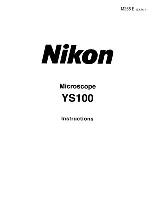
Chapter 3
Individual Operations
129
Indiv
idua
l
Op
eratio
n
s
16.8
Switching the Barrier Filter (Motorized Barrier Filter Wheel)
By attaching a motorized barrier filter wheel between the
epi-fluorescence cube turret and the quadrocular tilting tube,
switching of barrier filters can be motorized. The wheel has one
empty hole and seven slots. The empty hole is address 1 and
the barrier filter cannot be attached here. Attach the desired
barrier filter (
25/thickness 5 mm or less) in a slot at address 2
to 8.
For information on attaching barrier filters, see Chapter 1 “3
Assembly Method - 11 Attach the motorized barrier filter wheel”
in the “Assembly/Maintenance” instruction manual.
Configure the information on the barrier filters to attach to the
wheel on DS-L3. (See “23 Operation on DS-L3” - “23.1 Setting
Up the Microscope - (1) Setting Optical Elements Installation
Information” for details.)
The wheel is rotated by the FUNCTION button on the Ni-E
microscope main body. Press FUNCTION button 5 or 6 to rotate
the wheel counterclockwise or clockwise and change the wheel
address one by one. A barrier filter indicated on the display
panel on the front of the Ni-E microscope is brought into the
optical path.
The filter number of the barrier filter currently in the optical path
can be checked also via the window on the filter replacement
cover on front of the barrier filter wheel. Filter nameplates can
also be attached onto the replacement cover for your
convenience.
Operation on DS-L3 (See “23.2 Controlling the Microscope”.)
5
A
λ
5
4
3
2
1
ND4
ND8
ND16
1
1
O
2
3
4
5
6
7
8
50
60
70
Switching of barrier filter
B A 4 0 0
_ _ _ _ _
D A P I
_
- 2
'
C
_ _ _ _ _
E X 3 3 0 - 3 8 0
_
U V - 2 B
'
C
_ _
E P I : C
16.9
Other Notes on Epi-fluorescence Microscopy
■
Using a non-fluorescent slide, cover glass, and immersion oil
For fluorescence observations, be sure to use a non-fluorescent slide, cover glass, and our designated immersion oil
for an image with better contrast.
■
Locating a target in the sample
The standard procedure for epi-fluorescence microscopy is to first locate the target under differential interference
contrast or phase contrast microscopy, and then switch to epi-fluorescence microscopy. To locate the target under
dia-illumination bright-field microscopy, you will need to note the following.
Under dia-illumination bright-field microscopy, start with a 10x objective, and adequately stop down the condenser.
Gradually increase the magnification. When the target becomes difficult to locate, switch to epi-fluorescence, and
use low excitation light.
You can also use other techniques, such as using the edge of the cover glass to approximate the position of the
target.
■
Protecting from ultraviolet light (light shielding plate)
The light shielding plate is used to prevent the reflected ultraviolet light from entering the observer's eyes, which is
originally emitted through the objective, from the specimen.
Wheel
address in
optical path
Filter
nameplate
Motorized barrier
filter wheel
Summary of Contents for ECLIPSE Ni-E
Page 2: ......
Page 24: ...Chapter 1 Components 10 Components ...
Page 29: ...Chapter 2 Microscopy Operations 15 Before Microscopy Operation Flowchart ...
Page 30: ...Chapter 2 Microscopy Operations 16 Before Microscopy Operation Flowchart ...
Page 31: ...Chapter 2 Microscopy Operations 17 Before Microscopy Operation Flowchart ...
















































